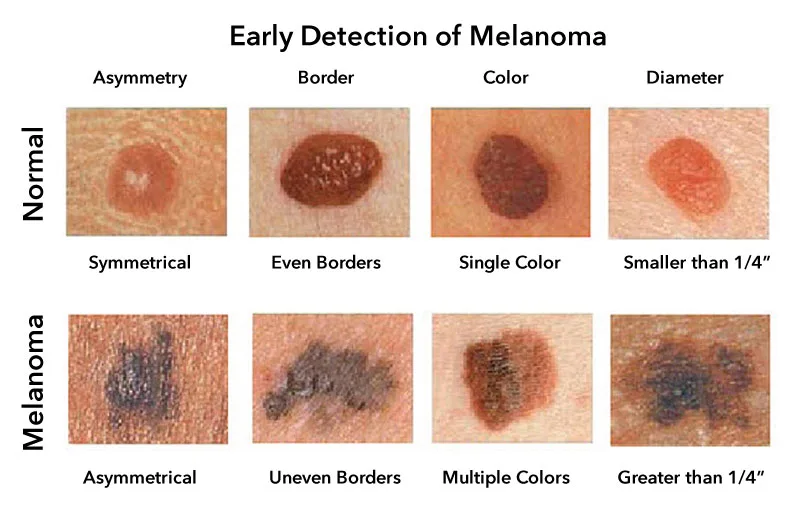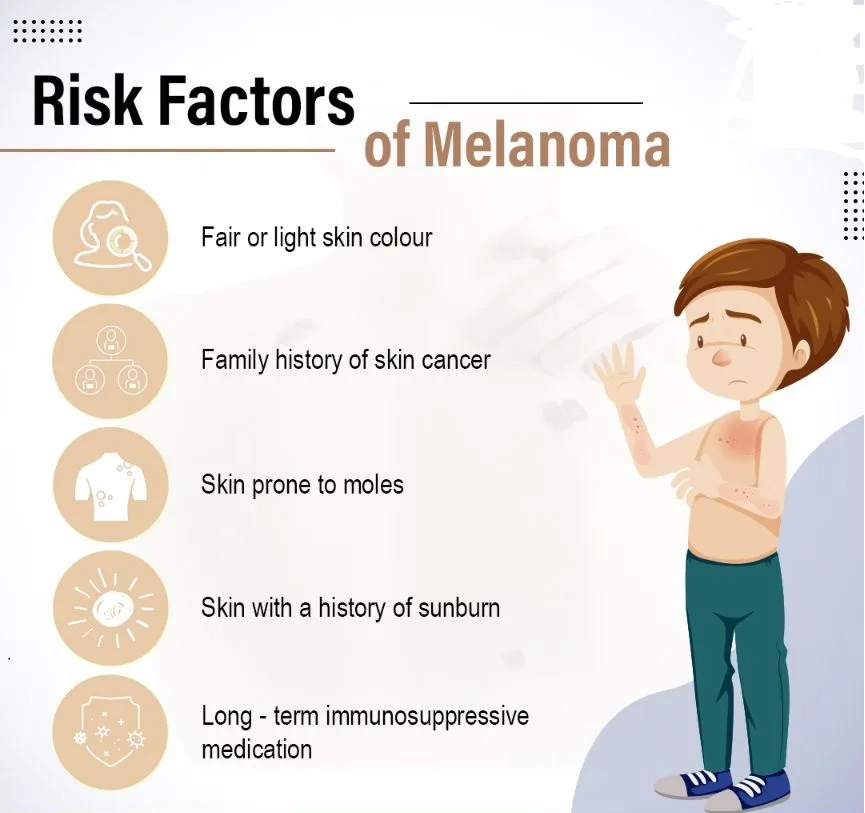As summer approaches and the sun graces us with its warm embrace, it’s crucial to take a moment to reflect on the health of our skin. Melanoma, one of the most serious forms of skin cancer, often goes unnoticed in its early stages, but with awareness and education, we can empower ourselves to spot the signs and take proactive measures. Understanding the risks associated with excessive sun exposure, recognizing the danger signals our skin may exhibit, and knowing how to protect ourselves are essential steps in the fight against this aggressive cancer. In this article, we’ll delve into the vital signs of melanoma, how to recognize them, and the best practices for safeguarding your skin. Let’s embark on this journey toward awareness and make a commitment to prioritize our skin health.
Melanoma Awareness: Spot the Signs, Protect Your Skin
As the sun begins to shine brighter and outdoor activities increase, it’s essential to turn our attention to a critical health concern that affects millions: melanoma. This aggressive form of skin cancer is known for its ability to spread quickly, making early detection and awareness paramount. While many of us enjoy basking in the sun’s rays, it’s crucial to understand the importance of protecting our skin and being vigilant about any changes. In this blog post, we will explore
Introduction:
As the sun’s rays beckon us outdoors, it’s crucial to remember the impact they can have on our skin health. With skin cancer rates steadily rising, melanoma—the deadliest form of skin cancer—continues to pose a significant threat. Raising awareness about melanoma is essential, as early detection and education about its signs can save lives. By learning to spot the early signs of this aggressive disease and understanding the importance of protective measures, we empower ourselves and our loved ones to take proactive steps toward skin safety. Your skin is your body’s first line of defense, and knowing how to care for it effectively can make all the difference in the fight against melanoma.
Melanoma can sneak up on you, turning a mole into a serious skin cancer. Sarah, a 35-year-old graphic designer, found this out the hard way. A small spot on her shoulder turned her world upside down. Her story shows how vital early detection is in fighting this aggressive cancer1.
Skin cancer is a big problem in the U.S., with melanoma being the most dangerous type. Catching it early can make a huge difference. People who find melanoma early have a 99% chance of surviving five years1. This shows how important it is to stay alert and check your skin often2.
To understand melanoma, you need to know it’s different. It starts in melanocytes, the cells that make skin color. It can pop up in places you least expect, affecting 70 to 80% of people13.
Key Takeaways
- Early detection is key to beating melanoma
- 99% of melanoma cases can be cured if caught early
- Melanoma can develop in unexpected skin areas
- Regular self-examinations are essential
- Professional skin screenings can save lives
Understanding Melanoma: The Most Dangerous Skin Cancer
Melanoma is the most serious skin cancer, affecting people all over the world4. In 2023, nearly 187,000 Americans will be diagnosed with it4. Knowing its unique traits is key for early detection and treatment.
Melanoma is aggressive and can spread fast5. It’s the rarest but most dangerous skin cancer54. About 90% of melanoma cases are caused by UV rays4.
Unique Characteristics of Melanoma
Melanoma comes in different types, showing its complexity:
- 5Superficial spreading melanoma: 70% of all cases2
- 5Nodular melanoma: 20% of skin melanomas2
- 5Acral lentiginous melanoma: More common in individuals with darker skin tones2
Impact of Early Detection
4Over 97,600 invasive melanoma cases are expected in 20234. Early detection boosts survival chances, making regular skin checks vital4. Metastatic melanoma, which spreads to lymph nodes or distant organs, is the most serious4.
Common Melanoma Locations
5Men and women have different melanoma spots. Men often get it on the trunk, while women get it on their legs5. This shows why full skin checks are important.
The Critical ABCDEs of Melanoma Detection
Finding melanoma early can greatly increase chances of survival. The ABCDE method is key for spotting dangerous skin changes6. It helps people identify moles that might be melanoma7.
- A – Asymmetry: Normal moles are symmetrical. If a mole is not even, it might be a sign6.
- B – Border: Moles with irregular edges could be melanoma6.
- C – Color: Moles with many colors are suspicious. Look for different shades of tan, brown, black, or sometimes red, white, or blue6.
- D – Diameter: Melanomas are usually bigger than 6 millimeters (like a pencil eraser)6.
- E – Evolving: Changes in size, shape, or color over time need quick attention6.
“Early detection is your best defense against melanoma” – Skin Cancer Foundation
Not all moles with these signs are cancer, but knowing the ABCDE method helps catch melanoma early. Melanoma can appear anywhere on the skin, with different spots common in men and women6. Risk factors include being fair-skinned, getting a lot of sun, and having a family history6.
Experts say to check your skin often and get professional checks. If you see anything odd, see a dermatologist right away7.
Recognizing the “Ugly Duckling” Sign in Skin Lesions
Spotting melanoma needs sharp eyes and knowing skin changes. The “ugly duckling” idea helps spot odd moles that don’t match others8. It looks at each mole’s unique traits9.
The “ugly duckling” sign is when a mole looks very different from others9. Most moles look similar, so any that don’t could be a sign of melanoma10.
Comparing Suspicious Moles
When checking moles, use these tips:
- Look for moles that are significantly different in size
- Compare their colors
- Check if their shapes are irregular
- Notice any unique textures or looks
Identifying Isolated Lesions
Some melanomas show up alone, without others to compare to. Watch for these signs:
- Asymmetrical shape
- Irregular borders
- Multiple colors
- Size bigger than 6mm
- Changes in size or look over time
A new tech has shown it can spot suspicious moles very well, agreeing with doctors 88% of the time10. This tech helps with early mole detection.
Common Risk Factors for Melanoma Development
It’s key to know about melanoma risk factors for early detection and prevention. In 2025, about 104,960 adults in the United States will be diagnosed with melanoma. This makes it more important than ever to be aware of these risks11.
Melanoma risk factors fall into several main areas:
-
Genetic Predisposition
- Family history of melanoma
- Genetic mutations that increase susceptibility
-
Physical Characteristics
- Light skin tone
- Light-colored hair
- Light-colored eyes
- Skin prone to burning easily
-
Environmental Exposure
- Frequent UV radiation exposure
- Multiple blistering sunburns as a child
- Tanning bed use
Men and certain types of tumors are at higher risk for melanoma spreading. Tumors thicker than 4 mm, nodular melanoma, and ulceration can raise the risk of melanoma getting worse11.
People with weak immune systems or exposure to certain environmental factors like radiation face higher risks. Early detection is vital, as about 4 percent of melanoma cases are diagnosed at the most advanced stage11.
Remember: Knowing your risk factors empowers you to take proactive steps in skin cancer prevention and early detection.
Special Types of Melanoma to Watch For
Melanoma isn’t always easy to spot. Some rare types of skin cancer can be hard to find. Knowing about these unique melanomas is key to catching them early12.
Most people know about dark moles. But, some melanomas look different. They can be tricky to spot during regular skin checks13.
Amelanotic Melanoma: The Invisible Threat
Amelanotic melanoma is a big challenge in finding skin cancer. These tumors don’t have the usual dark color. They look like pink, red, or flesh-colored patches12.
They can be mistaken for harmless skin issues. This makes them hard to see without training12.
Acral Lentiginous Melanoma: A Hidden Danger
This rare melanoma mainly affects people with darker skin. It shows up in places you wouldn’t expect. Acral lentiginous melanoma often appears on:
- Palms of hands
- Soles of feet
- Under fingernails or toenails
Because of where it grows, it’s often missed until it’s too late13.
Nodular Melanoma: Aggressive and Fast-Growing
Nodular melanoma grows fast and is very aggressive. It makes up 10-15% of melanoma cases12. It doesn’t always follow the usual ABCDE rules for detection. So, getting a professional skin check is very important.
“Early detection is the key to surviving melanoma, even with these unusual types.” – Dermatology Experts
It’s important for patients to stay alert and get regular skin checks. This is even more true if you have risk factors or notice any unusual skin changes13.
Essential Prevention Strategies
Preventing skin cancer means protecting your skin from harmful UV radiation. UV light causes 95% of melanomas, making sun protection key14. Knowing and using good prevention methods can lower your risk of skin cancer.
Important prevention steps include:
- Use broad-spectrum sunscreen with at least SPF 5014
- Apply sunscreen using the ‘7 teaspoon’ rule14
- Seek shade during peak sunlight hours
- Wear protective clothing
- Avoid tanning beds
Sunscreen is vital when the UV index is 3 and above14. Very fair-skinned people need protection even at lower UV levels14. Sunburn in childhood raises melanoma risk in adulthood, so kids need protection too14.
Regular skin checks can spot moles early. These checks may cut melanoma deaths by up to 63%15. If you have many moles or are at high risk, see a dermatologist regularly16.
Protecting your skin is an ongoing commitment to your long-term health.
Professional Skin Examinations: When and How Often
Regular visits to the dermatologist are key for skin health. They help catch problems early. Professional exams offer a detailed look that self-screenings can’t match17.
Most people should get a skin exam once a year. Those at higher risk might need more often18. The exam usually takes about 10 minutes and spots areas missed by personal checks17.
What to Expect During Your Screening
Dermatologists use special tools like a dermatoscope during exams. This lets them see the skin’s layers with great detail17.
- Full-body examination of all skin surfaces
- Documentation of existing moles and lesions
- Assessment of possible cancer signs
- Potential biopsy if something looks off
Documentation and Follow-up Care
Keeping detailed records is important in skin exams. Dermatologists often take photos and measure moles to watch for changes18. If they find something suspicious, they might suggest a biopsy.
| Exam Frequency | Patient Risk Level |
|---|---|
| Annually | General Population |
| Bi-annually or More | High-Risk Individuals |
Early detection is the best way to treat skin cancer effectively17. Regular exams can catch problems before they get worse.
Self-Examination Techniques and Best Practices
Protecting your skin begins with self-monitoring. Many melanomas are found through personal checks. This makes monthly exams key for early detection19. Regular self-exams help track mole changes and spot suspicious skin20.
Experts suggest a detailed approach for skin checks. Here are essential steps for an effective self-exam:
- Examine your entire body in a well-lit room with multiple mirrors
- Check hard-to-see areas like back, scalp, and between toes
- Use good lighting and consider asking a partner for assistance
- Document existing moles through photography or body mapping
When checking moles, remember the ABCDE guidelines:
- Asymmetry: Look for irregular shapes
- Borders: Check for uneven or jagged edges
- Color: Note variations or multiple colors
- Diameter: Watch for moles larger than 6mm
- Evolving: Track any changes over time
Those at higher risk should be extra careful. This includes people with many moles, weakened immunity, or a family history of skin cancer20. If you spot any odd changes, see a doctor right away19.
| Risk Level | Recommended Frequency |
|---|---|
| Low Risk | Monthly self-exams |
| High Risk | Monthly self-exams + Bi-annual professional screenings |
Early detection can significantly improve melanoma treatment outcomes19.
Treatment Options and Medical Interventions
Melanoma treatment depends on the cancer’s stage and its unique features. Surgery is the main treatment for most melanomas. The type of surgery needed changes based on how far the cancer has spread21.
For early melanomas, doctors often use surgery to remove the cancer. For stage 0 and stage I melanomas, they use wide excision. This method removes the cancer and some healthy skin around it22. The biopsy is key in deciding the best treatment23.
- Surgery for early-stage melanoma
- Sentinel lymph node biopsy for stage assessment
- Advanced treatment options for metastatic cases
For more advanced melanomas, doctors use a mix of treatments. Immunotherapy and targeted therapy are big steps forward for treating melanoma that has spread21. About half of melanomas have changes in the BRAF gene. This makes targeted therapies very effective22.
| Treatment Stage | Primary Intervention |
|---|---|
| Stage 0-I | Surgical Excision |
| Stage II-III | Surgery + Adjuvant Therapy |
| Stage IV | Immunotherapy, Targeted Therapy |
Stage IV melanoma treatment is more complex. Drugs like pembrolizumab and nivolumab are often the first choice. Clinical trials are also a big part of treatment for advanced melanoma22.
Early detection significantly improves treatment success and expands available medical interventions.
It’s important for patients to work with their oncology team. Together, they can create a treatment plan that fits the patient’s specific melanoma23.
The Role of Sun Protection in Prevention
Keeping your skin safe from harmful UV rays is key to avoiding skin cancer. Melanoma and other serious skin issues can be lowered with good sun protection2425.
The rate of cutaneous malignant melanoma is going up. It’s now increasing by 3% every year25.
Choosing the Right Sunscreen
Finding the right sunscreen is not easy. It’s not just about picking any sunscreen. You need to consider a few things:
- Use broad-spectrum SPF 15+ or higher
- Apply a thick, even layer
- Reapply every two hours
- Cover most exposed skin areas
But, many people don’t use sunscreen right. Only 4.8% apply it thick enough, and only 9.6% reapply often enough24.
Protective Clothing and Accessories
Wearing the right clothes is also important for skin cancer prevention:
- Wear long-sleeved, tightly woven clothing
- Choose UPF-rated garments
- Use wide-brimmed hats
- Wear UV-blocking sunglasses
Timing of Sun Exposure
Stay out of the sun during peak hours, 10 am to 4 pm. Wearing sunscreen all the time can lower your risk of melanoma. Studies show sunscreen users have a 0.44 adjusted odds ratio24.
“Prevention is always better than cure when it comes to skin cancer protection.”
Remember, sun protection is a year-round commitment, not just a summer strategy. Even though some studies disagree, taking action can lower your risk25.
Conclusion
Understanding melanoma is key to preventing and catching it early. In 2023, the US will see about 97,610 new melanoma cases. Sadly, around 7,990 people will die from this serious skin cancer26.
Melanoma is a big deal, causing 75% of skin cancer deaths. Yet, it only makes up 4% of all skin cancer cases27.
Early detection is the best way to fight melanoma. For melanoma caught early, the five-year survival rate is 99%. But, if it spreads, the survival rate drops to just 25%28.
By learning the ABCDE method and watching for the Ugly Duckling sign, you can greatly improve your chances of beating melanoma26.
Prevention is the first step in fighting melanoma. Regular skin checks, sun protection, and self-exams can help a lot. Remember, catching melanoma early can prevent it from spreading28.
Take care of your skin by staying informed and protecting it from UV rays. If you notice anything strange, get it checked by a doctor right away.
Your skin is your biggest organ, and it needs constant care. By being proactive, informed, and catching problems early, you can lower your risk of melanoma. This helps keep your skin healthy overall.
FAQ
What is melanoma and why is it considered the most dangerous type of skin cancer?
Melanoma is a serious skin cancer that grows in melanocytes, the cells that make pigment. It’s the most dangerous because it can spread quickly if caught late. This leads to lower survival rates compared to other skin cancers.
Unlike others, melanoma can spread to other parts of the body. Early detection is key for successful treatment.
How can I identify a potentially cancerous mole using the ABCDE method?
The ABCDE method helps spot suspicious moles: – Asymmetry: One half doesn’t match the other – Border: Edges are irregular, jagged, or scalloped – Color: Has multiple colors or uneven color – Diameter: Larger than 6mm (like a pencil eraser) – Evolving: Changes in size, shape, or color over time
What are the primary risk factors for developing melanoma?
Key risk factors include: – Fair skin and light hair – Severe sunburns – Family history of melanoma – Many moles – UV radiation exposure – Weakened immune system – Tanning beds – Previous skin cancers
How often should I get a professional skin examination?
It depends on your risk factors. Generally: – High-risk: Every 6-12 months – Moderate risk: Annually – Low risk: Every 2-3 years Talk to a dermatologist for your specific needs.
Are all melanomas pigmented and visible?
No, not all melanomas are pigmented. Amelanotic melanoma is rare and lacks pigmentation. It can appear as pink, red, or skin-colored, making it hard to spot.
This shows why professional skin checks and self-exams are so important.
What steps can I take to prevent melanoma?
To prevent melanoma, try these steps: – Use broad-spectrum sunscreen (SPF 30+) – Wear protective clothing – Avoid UV peak hours (10 am – 4 pm) – Stay away from tanning beds – Do monthly self-exams – Get regular skin screenings – Eat a healthy diet with antioxidants
What treatment options are available for melanoma?
Treatment varies by cancer stage and includes: – Surgery for early-stage melanoma – Immunotherapy to boost the immune system – Targeted therapy for specific mutations – Chemotherapy – Radiation therapy – Clinical trials for advanced cases Early detection improves treatment success and options.
What is the “Ugly Duckling” sign in skin cancer detection?
The “Ugly Duckling” sign helps spot suspicious moles by comparing them to others. A mole that looks different in size, shape, or color may be a warning sign. This method catches lesions that might not meet all ABCDE criteria but need a check.
Source Links
- https://www.skincancer.org/skin-cancer-information/melanoma/melanoma-warning-signs-and-images/
- https://www.healthline.com/health/skin-cancer-awareness-month
- https://www.mayoclinic.org/diseases-conditions/melanoma/symptoms-causes/syc-20374884
- https://melanoma.org/what-is-melanoma/understanding-melanoma/
- https://www.cancer.org/cancer/types/melanoma-skin-cancer/about/what-is-melanoma.html
- https://www.cancer.gov/types/skin/patient/melanoma-treatment-pdq
- https://emedicine.medscape.com/article/280245-overview
- https://pmc.ncbi.nlm.nih.gov/articles/PMC4345927/
- https://www.cancer.org/cancer/types/melanoma-skin-cancer/detection-diagnosis-staging/signs-and-symptoms.html
- https://wyss.harvard.edu/news/identifying-ugly-ducklings-to-catch-skin-cancer-earlier/
- https://www.cancercenter.com/cancer-types/melanoma/types/metastatic-melanoma
- https://www.skincancer.org/skin-cancer-information/melanoma/
- https://www.health.com/condition/melanoma/is-it-a-mole-or-skin-cancer
- https://melanoma.org.au/about-melanoma/how-to-prevent-melanoma/
- https://pmc.ncbi.nlm.nih.gov/articles/PMC3517928/
- https://www.cancer.org/cancer/types/melanoma-skin-cancer/causes-risks-prevention/prevention.html
- https://www.skincancer.org/early-detection/annual-exams/
- https://www.aimatmelanoma.org/melanoma-101/early-detection-of-melanoma/regular-skin-examinations-by-your-doctor/
- https://www.aimatmelanoma.org/melanoma-101/early-detection-of-melanoma/how-to-do-a-skin-self-examination/
- https://www.cancer.org/cancer/risk-prevention/sun-and-uv/skin-exams.html
- https://www.nhs.uk/conditions/melanoma-skin-cancer/treatment/
- https://www.cancer.org/cancer/types/melanoma-skin-cancer/treating/by-stage.html
- https://www.mayoclinic.org/diseases-conditions/melanoma/diagnosis-treatment/drc-20374888
- https://pmc.ncbi.nlm.nih.gov/articles/PMC4399380/
- https://www.jabfm.org/content/24/6/735
- https://www.ncbi.nlm.nih.gov/books/NBK470409/
- https://pmc.ncbi.nlm.nih.gov/articles/PMC6804807/
- https://en.wikipedia.org/wiki/Melanoma







One comment
[…] family history is also key. If many relatives have had melanoma or related cancers, think about genetic counseling. Experts suggest it if you have three or more […]